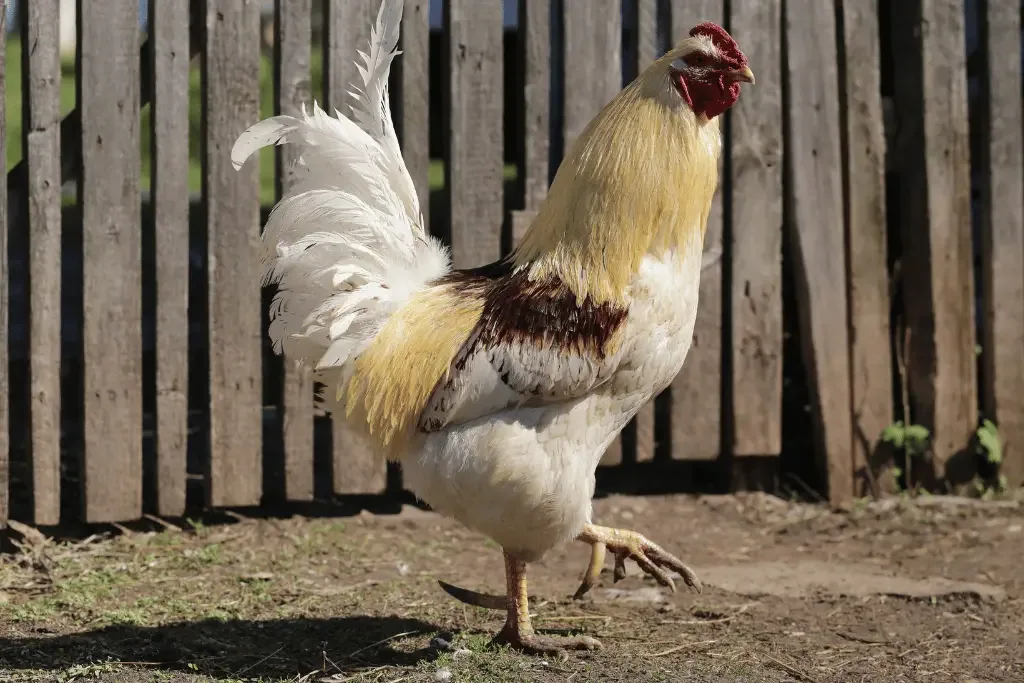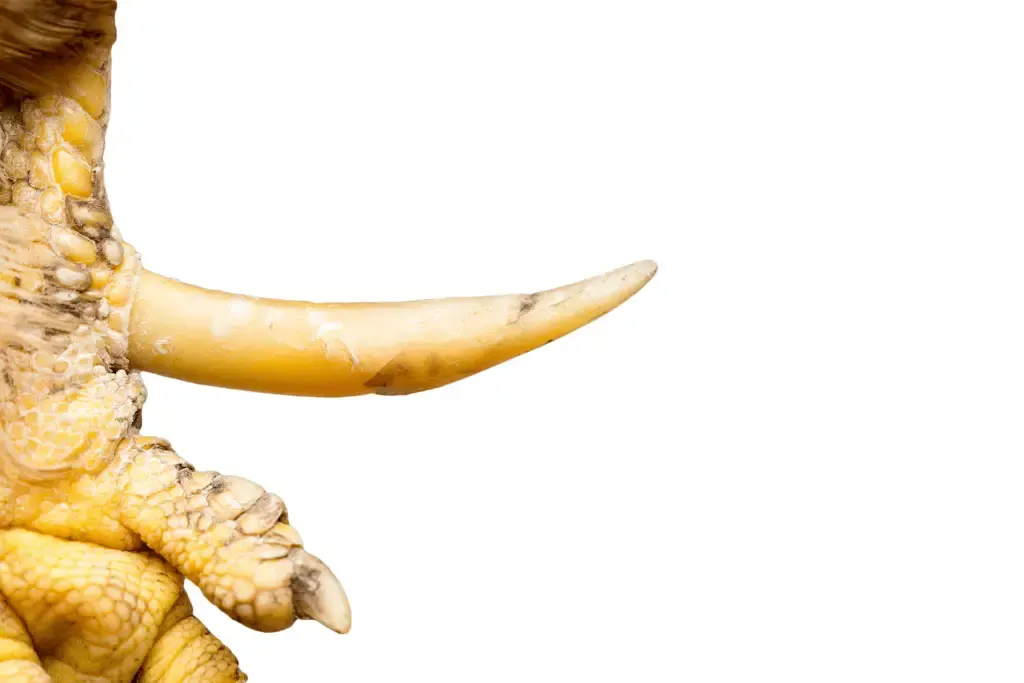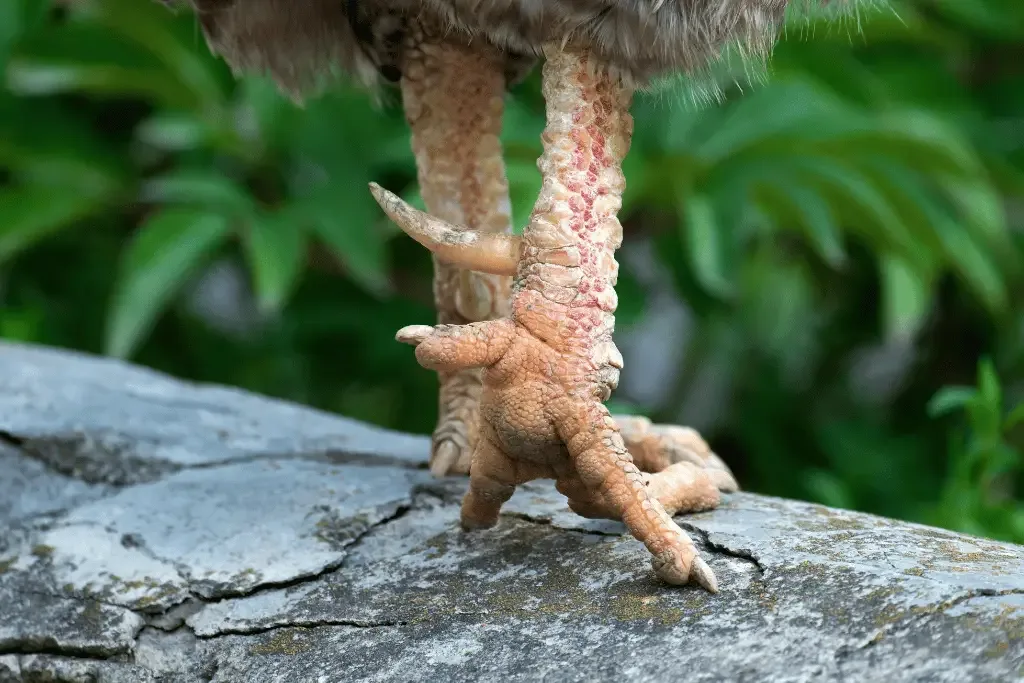Rooster spurs are a scary, but natural and common feature of roosters that can be found on the back of their legs.
They can grow up to several inches in length and become extremely sharp over time.
Roosters use their spurs for a few different reasons, including defending their flock from predators and competing with other roosters for dominance.
While spurs can be a great tool for roosters, they can also be dangerous for humans and other animals.
It is important for rooster owners to understand how to properly handle and care for their rooster’s spurs to prevent injury.
In this article, we will discuss:
- What rooster spurs are
- How rooster spurs grow
- How to safely trim or remove rooster spurs if necessary
- The risks of rooster spurs and how to protect yourself from them
- Some frequently asked questions

What are Rooster Spurs?
Rooster spurs are pointed, claw-like growths located on the back of a rooster’s leg.
These spurs are made of keratin, which is the same material that makes up their beaks and feathers.
This is also the same material found on some other animals such as sea turtle shells, cow hooves, or walrus tusks.
Spurs are a natural feature found on some roosters, and they serve several purposes.
When a rooster reaches sexual maturity, spur buds can start to grow from the leg bone.
These buds gradually develop into spurs, which can vary in size and shape depending on the breed and age of the rooster. Spurs can either be straight and sharp or curved and twisted.
Roosters use their spurs for protection and to defend themselves and their flock from predators and other threats. If a predator comes near, the rooster will puff up his feathers, make a lot of noise, and attack with his sharp spurs.
It’s important to note that not all roosters have spurs, and some may have only one spur or none at all.
Additionally, some hens have spurs as well, therefore it’s important not to sex your chickens this way, as spurs can grow on both genders of chicken.

Rooster Spurs and Breeds
Different breeds of roosters have different types of spurs.
For example, Leghorn roosters can have long, thin spurs that are not very sharp, while Sicilian Buttercup roosters can have large, curved spurs that are very sharp.
Ancona roosters can have thick, curved spurs that are also very sharp, and Polish roosters have small, straight spurs that are not very sharp.
Mediterranean breeds, in general, tend to have longer and sharper spurs than other breeds.
The hen-to-rooster ratio can also affect the size and sharpness of rooster spurs.
If there are too many roosters in a flock, they may fight more often, which can lead to larger and sharper spurs.
Conversely, if there are too few roosters, they may not need to use their spurs as much, which can lead to smaller and less sharp spurs.
It is important to be cautious around roosters with spurs, especially if they are aggressive.
If necessary, spurs can be trimmed or removed by a veterinarian or experienced chicken keeper.
However, this should only be done if the rooster’s spurs are causing harm to other chickens or humans.
Rooster Spurs as Defense Mechanism
Rooster spurs play a crucial role in a rooster’s defense mechanism.
They are used as weapons by roosters to defend themselves, their hens, and their flock against predators and other threats.
Roosters are naturally aggressive and territorial birds, and they use their spurs to establish dominance over other roosters and protect their hens.
When a predator or a threat approaches, a rooster will leap up and use its spurs to attack and defend itself and its flock.
Rooster spurs are incredibly sharp and can puncture the skin of a perceived threat, predator, or competitor.
Rooster spurs are not only used for defense but also for flock protection.
Roosters are the first line of defense against threats and watch over their hens 24/7 and they tend to use their spurs to ward off predators and keep their flock safe from harm.
However, rooster spurs can also be dangerous to humans and other animals.
They can cause serious injuries, especially if the rooster is aggressive or feels threatened.
Therefore, it is essential to handle roosters with care and caution, especially when trimming their spurs.
The Implications of Rooster Aggression
Rooster aggression can be a serious problem for backyard chicken owners.
Aggressive roosters can cause harm to both humans and other chickens.
Roosters can become aggressive for a variety of reasons, including protecting their hens, establishing dominance, or feeling threatened.
One of the main ways that roosters establish dominance is through the pecking order, which is a social hierarchy that exists within a flock of chickens.
Roosters will often assert their dominance over other chickens by pecking them on the head or comb, the fleshy red crest on top of a chicken’s head.
To prevent rooster aggression, it is important to establish yourself as the dominant figure in the flock.
This can be done by spending time with the chickens and handling them regularly.
It is also important to keep the flock size small and to provide plenty of space and resources for the chickens.
If a rooster does become aggressive, there are several steps that can be taken to address the problem:
- Removing the rooster from the flock
- Separating the rooster from the hens
- Using physical barriers to protect humans and other chickens from the rooster’s aggression

Potential Risks and Injuries
Rooster spurs can pose potential risks and injuries to both humans and other birds.
The sharp and pointed spurs can cause damage to the skin, puncture wounds, and even lead to infection.
Injuries caused by rooster spurs can vary in severity, from minor cuts to more serious wounds that require medical attention.
One of the most common injuries caused by rooster spurs is foot damage.
Roosters use their spurs for protection, and when they attack, they often aim for the feet of their target.
This can result in lameness, making it difficult for the bird to walk or stand. In severe cases, the foot may become infected, leading to further complications.
Another risk associated with rooster spurs is injury to other birds.
Roosters can use their spurs to injure hens during mating, which can lead to open wounds that are susceptible to infection.
Additionally, unruly spurs can injure other birds in the flock, leading to a higher risk of injury because the open wounds invite other birds to pick at them.
If a person is scratched or punctured by a rooster’s spur, it is important to clean the wound thoroughly and apply an antiseptic to prevent infection.
In some cases, medical attention may be necessary to ensure proper healing.
Trimming and Removing Rooster Spurs
Rooster spurs are extremely sharp and can cause injury to other chickens. pets, and humans.
It is essential to maintain them to prevent any harm.
Removing or trimming rooster spurs can be done using various tools such as clippers, metal files, and saws.
Trimming Rooster Spurs
Trimming rooster spurs is a simple process that can be done with clippers.
Keep in mind that trimming rooster spurs should be done with caution so that the rooster does not get injured in the process.
The following steps can be followed to trim rooster spurs:
- Hold the rooster securely to prevent it from moving or injuring itself.
- Use a pair of sharp clippers to trim the tip of the spur.
- Avoid cutting the quick, which is the blood vessel that runs through the spur. Cutting the quick can cause bleeding and pain to the rooster.
- If the spur is too long, it can be filed down using a metal file or a Dremel tool.
Maintaining Rooster Spurs
Regular maintenance of rooster spurs is essential to prevent them from growing too long and causing harm.
Trimming the spurs every few months can help keep them at a manageable length.
Filing the spurs down can also help prevent them from becoming too sharp.
Removing Rooster Spurs
Removing rooster spurs is a more invasive process that involves cutting the spur off completely.
This process should only be done by a professional and not attempted at home.
Removing rooster spurs can seriously injure the chicken if it is not done correctly.
Professionals, such as veterinarians, have the knowledge and tools necessary to safely and effectively manage rooster spurs.
A veterinarian will also be able to look at your rooster’s spurs to determine if the spur can be trimmed or if it needs to be safely removed.
Keep in mind that removing a rooster’s spurs is not going to necessarily stop his aggression.
Roosters have plenty of other ways of harming you or other chickens if they want to.
If you have an overly aggressive bird that continues to patronize you or your flock, culling the rooster may be the best option to maintain peace in your backyard.
Dealing with Rooster Spur Infections
Rooster spurs can sometimes become infected, which can be painful for the rooster and potentially dangerous for the rest of the flock.
Infections can occur when the rooster’s spur is damaged or when bacteria enter through a break in the skin.
If you notice any signs of infection, such as redness, swelling, or discharge around the spur, it is important to take action immediately.
Here are some steps you can take to deal with infections:
- Clean the area: Use a mild antiseptic solution to clean the area around the infected spur. This will help to prevent the infection from spreading and promote healing.
- Apply an antibiotic ointment: Apply a small amount of antibiotic ointment to the infected area. This will help to kill any bacteria that may be causing the infection and prevent it from getting worse.
- Monitor the rooster: Keep a close eye on the rooster to make sure that the infection is not getting worse. If you notice any signs of worsening infection, such as fever or lethargy, contact a veterinarian immediately.
It is important to note that infections can sometimes be caused by improper handling of the rooster’s spurs.
If you are not experienced in handling rooster spurs, it may be best to seek advice from a professional.
By taking these steps, you can help prevent infections and ensure that your rooster remains healthy and happy.
Final Thoughts
While rooster spurs are a natural part of a rooster’s anatomy, there are some important considerations to keep in mind when dealing with them.
First, their spurs can be sharp and dangerous, both to other animals and to humans. It’s important to handle roosters with care and to be aware of their spurs at all times.
Secondly, rooster spurs can become quite long and sharp over time, which can make them even more dangerous.
It may be necessary to trim or remove the spurs to prevent injury, however, this should only be done by a trained professional, as it can be a delicate and potentially dangerous process.
It’s also important to be aware of the potential for injury when handling roosters with spurs.
The sharp edges of the spurs can easily puncture skin, and if not properly cleaned, can lead to infection.
The spikes of the spurs can also damage blood vessels and other delicate tissues, leading to pain and potential long-term damage.
Despite these considerations, roosters with spurs can still be gentle and friendly animals, as long as they are treated with respect and care.
By being aware of their spurs and taking appropriate precautions, it is possible to enjoy these amazing birds without putting yourself or others in danger.
Frequently Asked Questions
What does it mean when a rooster spurs you?
When a rooster spurs you, they will leap into the air and use their spurs on the backs of their legs to injure a part of your body, including your feet, calves, or legs.
These sharp spurs can cause a lot of damage to the skin by leaving puncture wounds and deep scratches.
How old is a rooster when it gets spurs?
Most roosters will develop spurs at around 6-9 months of age.
However, some roosters can have fully formed spurs as young as 3 months old.
What is the purpose of a rooster’s spurs?
The purpose of a rooster’s spurs is to protect the flock from predators and other threats.
They can also be used in fights with other roosters for dominance.
How can you prevent rooster spur injuries?
To prevent rooster spur injuries, it’s important to handle roosters gently and avoid startling or threatening them.
Wearing protective clothing such as gloves and long sleeves can also help.
Keeping roosters in separate areas from other birds can also reduce the risk of injury.
How do you stop a rooster from spurring you?
If a rooster is spurring you, it is important to assert your dominance and walk towards the rooster confidently and boldly to make him retreat.
If this doesn’t work, you can gently spray the rooster with water from a hose or a spray bottle.
In some cases, overly aggressive roosters may need to be culled in order to avoid injuries to yourself, other animals, and your flock.

